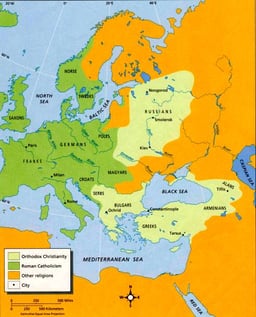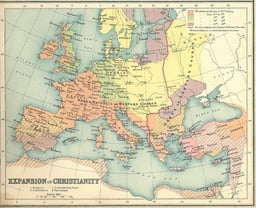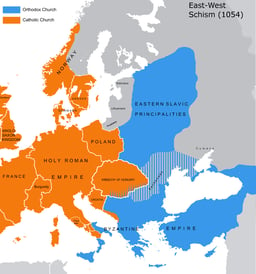Eastern Europe
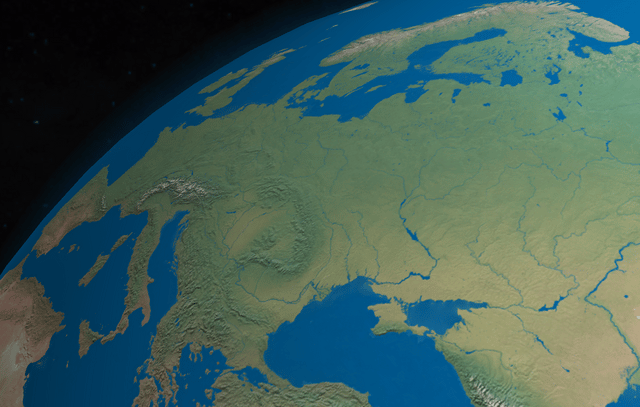
Eastern Europe
Eastern Europe is the eastern part of the European continent. There is no consistent definition of the precise area it covers, partly because the term has a wide range of geopolitical, geographical, cultural, and socioeconomic connotations. There are "almost as many definitions of Eastern Europe as there are scholars of the region".[1] A related United Nations paper adds that "every assessment of spatial identities is essentially a social and cultural construct".[2] One definition describes Eastern Europe as a cultural entity: the region lying in Europe with the main characteristics consisting of Greek, Byzantine, Eastern Orthodox, Russian, and some Ottoman culture influences.[3][4] Another definition was created during the Cold War and used more or less synonymously with the term Eastern Bloc. A similar definition names the formerly communist European states outside the Soviet Union as Eastern Europe.[4] The majority of historians and social scientists view such definitions as outdated or relegated,[1][5][6][7][8] but they are still sometimes used for statistical purposes.[3][9][10]
Definitions

Regions used for statistical processing purposes by the United Nations Statistics Division "Eastern Europe"[3][10]

European regional grouping according to The World Factbook "Eastern Europe", here it is equivalent to the European part of the former Soviet Union
Several definitions of Eastern Europe exist today, but they often lack precision, are too general, or are outdated. These definitions vary both across cultures and among experts, even political scientists,[11] as the term has a wide range of geopolitical, geographical, cultural, and socioeconomic connotations.
There are "almost as many definitions of Eastern Europe as there are scholars of the region".[1] A related United Nations paper adds that "every assessment of spatial identities is essentially a social and cultural construct".[2]
Geographical
While the eastern geographical boundaries of Europe are well defined, the boundary between Eastern and Western Europe is not geographical but historical, religious and cultural.
The Ural Mountains, Ural River, and the Caucasus Mountains are the geographical land border of the eastern edge of Europe.
In the west, however, the historical and cultural boundaries of "Eastern Europe" are subject to some overlap and, most importantly, have undergone historical fluctuations, which makes a precise definition of the western geographic boundaries of Eastern Europe and the geographical midpoint of Europe somewhat difficult.
Religious
The East–West Schism (which began in the 11th century and lasts until the present) divided Christianity in Europe, and consequently, the world, into Western Christianity and Eastern Christianity.
Western Europe according to this point of view is formed by countries with dominant Roman Catholic and Protestant churches (including Central European countries like Slovenia, Austria, the Czech Republic, Germany, Hungary, Poland, and Slovakia).
Eastern Europe is formed by countries with dominant Eastern Orthodox churches, like Belarus, Bulgaria, Greece, Moldova, Montenegro, North Macedonia, Romania, Russia, Serbia, and Ukraine for instance.
The schism is the break of communion and theology between what are now the Eastern (Orthodox) and Western (Roman Catholic from the 11th century, as well as from the 16th century also Protestant) churches. This division dominated Europe for centuries, in opposition to the rather short-lived Cold War division of 4 decades.
Since the Great Schism of 1054, Europe has been divided between Roman Catholic and Protestant churches in the West, and the Eastern Orthodox Christian (many times incorrectly labeled "Greek Orthodox") churches in the east. Due to this religious cleavage, Eastern Orthodox countries are often associated with Eastern Europe. A cleavage of this sort is, however, often problematic; for example, Greece is overwhelmingly Orthodox, but is very rarely included in "Eastern Europe", for a variety of reasons, the most prominent being that Greece's history, for the most part, was more so influenced by Mediterranean cultures and contact.[15]
Cold War
The fall of the Iron Curtain brought the end of the East-West division in Europe,[16] but this geopolitical concept is sometimes still used for quick reference by the media or sometimes for statistical purposes.[17] Another definition was used during the 40 years of Cold War between 1947 and 1989, and was more or less synonymous with the terms Eastern Bloc and Warsaw Pact. A similar definition names the formerly communist European states outside the Soviet Union as Eastern Europe.[4]
Eurovoc
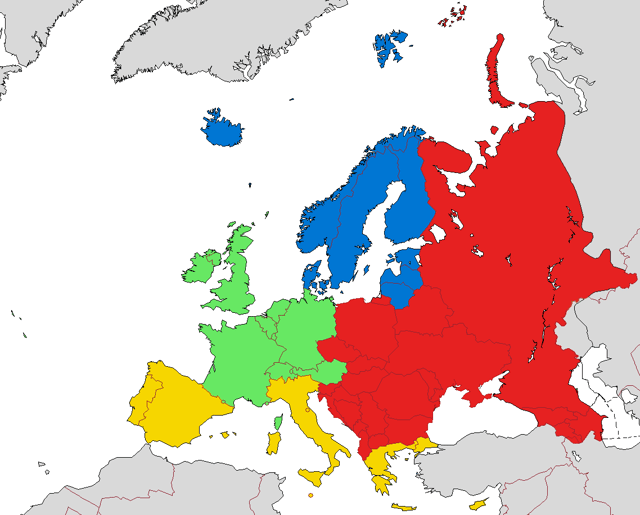
European sub-regions according to Eurovoc "Central and Eastern Europe"
Eurovoc, a multilingual thesaurus maintained by the Publications Office of the European Union, has entries for "23 EU languages"[18] (Bulgarian, Croatian, Czech, Danish, Dutch, English, Estonian, Finnish, French, German, Greek, Hungarian, Italian, Latvian, Lithuanian, Maltese, Polish, Portuguese, Romanian, Slovak, Slovenian, Spanish and Swedish), plus the languages of candidate countries (Albanian, Macedonian and Serbian). Of these, those in italics are classified as "Central and Eastern Europe" in this source.[19]
Contemporary developments
Baltic states
UNESCO,[20] EuroVoc, National Geographic Society, Committee for International Cooperation in National Research in Demography, STW Thesaurus for Economics place the Baltic states in Northern Europe, whereas the CIA World Factbook places the region in Eastern Europe with a strong assimilation to Northern Europe. They are members of the Nordic-Baltic Eight regional cooperation forum whereas Central European countries formed their own alliance called the Visegrád Group.[21] The Northern Future Forum, the Nordic Investment Bank, the Nordic Battlegroup, the Nordic-Baltic Eight and the New Hanseatic League are other examples of Northern European cooperation that includes the three countries collectively referred to as the Baltic states.
Estonia
Lithuania
Caucasus
The Caucasus nations of Armenia, Azerbaijan, and Georgia are included in definitions or histories of Eastern Europe. They are located in the transition zone of Eastern Europe and Western Asia. They participate in the European Union's Eastern Partnership program, the Euronest Parliamentary Assembly, and are members of the Council of Europe, which specifies that all three have political and cultural connections to Europe. In January 2002, the European Parliament noted that Armenia and Georgia may enter the EU in the future.[22] However, Georgia is currently the only Caucasus nation actively seeking NATO and EU membership.
Armenia
Georgia
There are three de facto independent Republics with limited recognition in the Caucasus region. All three states participate in the Community for Democracy and Rights of Nations:
Republic of Abkhazia
Republic of Artsakh
South Ossetia
Other former Soviet states
Several other former Soviet republics may be considered part of Eastern Europe
Belarus
Russia is a transcontinental country where the Western part is in Eastern Europe and the Eastern part is in Northern Asia.
Ukraine
Disputed states:
Transnistria
Central Europe
The term "Central Europe" is often used by historians to designate states formerly belonging to the Holy Roman Empire, the Austro-Hungarian Empire, and the Polish–Lithuanian Commonwealth.
Southeastern Europe
Some countries in Southeast Europe can be considered part of Eastern Europe. Some of them can sometimes, albeit rarely, be characterized as belonging to Southern Europe,[3] and some may also be included in Central Europe.
In some media, "Southeast Europe" can thus partially overlap with "Eastern Europe" of the Cold War Era. The following countries are labeled Southeast European by some commentators, though others still consider them to be Eastern European.[31]
Albania
Bulgaria
Croatia (can variously be included in Southeastern[27] or Central Europe)[28]
Greece
North Macedonia
Romania (can variously be included in Southeastern[32] or Central Europe)[33]
Serbia (mostly placed in Southeastern but sometimes in Central Europe)[29]
Slovenia (most often placed in Central Europe but sometimes in Southeastern Europe)[30]
Turkey (only the region East Thrace, west of the Dardanelles, the Sea of Marmara, and the Bosphorus; constitutes less than 3% of the country's total land mass)
Partially recognized states:
Kosovo
History
Classical antiquity and medieval origins
Ancient kingdoms of the region included Orontid Armenia, Caucasian Albania, Colchis and Iberia (not to be confused with the Iberian Peninsula in Western Europe). These kingdoms were either from the start, or later on incorporated into various Iranian empires, including the Achaemenid Persian, Parthian, and Sassanid Persian Empires.[34] Parts of the Balkans and some more northern areas were ruled by the Achaemenid Persians as well, including Thrace, Paeonia, Macedon, and most of the Black Sea coastal regions of Romania, Ukraine, and Russia.[35][36] Owing to the rivalry between the Parthian Empire and Rome, and later between Byzantium and the Sassanid Persians, the Parthians would invade the region several times, although it was never able to hold the area, unlike the Sassanids who controlled most of the Caucasus during their entire rule.[37]
The earliest known distinctions between east and west in Europe originate in the history of the Roman Republic. As the Roman domain expanded, a cultural and linguistic division appeared The mainly Greek-speaking eastern provinces had formed the highly urbanized Hellenistic civilization. In contrast, the western territories largely adopted the Latin language. This cultural and linguistic division was eventually reinforced by the later political east-west division of the Roman Empire. The division between these two spheres deepened during Late Antiquity and the Middle Ages due to a number of events. The Western Roman Empire collapsed in the 5th century, marking the start of the Early Middle Ages. By contrast, the Eastern Roman Empire mostly labeled as the Byzantine Empire by subsequent historians, managed to survive and even to thrive for another 1,000 years. The rise of the Frankish Empire in the west, and in particular the Great Schism that formally divided Eastern and Western Christianity in 1054, heightened the cultural and religious distinctiveness between Eastern and Western Europe. Much of Eastern Europe was invaded and occupied by the Mongols.
1453 to 1918
The conquest of the Byzantine Empire, center of the Eastern Orthodox Church, by the Ottoman Empire in the 15th century, and the gradual fragmentation of the Holy Roman Empire (which had replaced the Frankish empire) led to a change of the importance of Roman Catholic/Protestant vs. Eastern Orthodox concept in Europe. Armour points out that Cyrillic-alphabet use is not a strict determinant for Eastern Europe, where from Croatia to Poland and everywhere in between, the Latin alphabet is used.[38] Greece's status as the cradle of Western civilization and an integral part of the Western world in the political, cultural and economic spheres has led to it being nearly always classified as belonging not to Eastern, but Southern or Western Europe.[39] During the late-sixteenth and early-seventeenth centuries, Eastern Europe enjoyed a relatively high standard of living. This period is also called the east-central European golden age of around 1600.[40]
Interwar years
A major result of the First World War was the breakup of the Russian, Austro-Hungarian, and Ottoman empires, as well as partial losses to the German Empire. A surge of ethnic nationalism created a series of new states in Eastern Europe, validated by the Versailles Treaty of 1919. Poland was reconstituted after the partitions of the 1790s had divided it between Germany, Austria, and Russia. New countries included Finland, Estonia, Latvia, Lithuania, Ukraine (which was soon absorbed by the Soviet Union), Czechoslovakia, and Yugoslavia. Austria and Hungary had much-reduced boundaries. Romania, Bulgaria, and Albania likewise were independent. Many of the countries were still largely rural, with little industry and only a few urban centers. Nationalism was the dominant force but most of the countries had ethnic or religious minorities who felt threatened by majority elements. Nearly all became democratic in the 1920s, but all of them (except Czechoslovakia and Finland) gave up democracy during the depression years of the 1930s, in favor of autocratic or strong-man or single-party states. The new states were unable to form stable military alliances, and one by one were too weak to stand up against Nazi Germany or the Soviet Union, which took them over between 1938 and 1945.
World War II and the onset of the Cold War
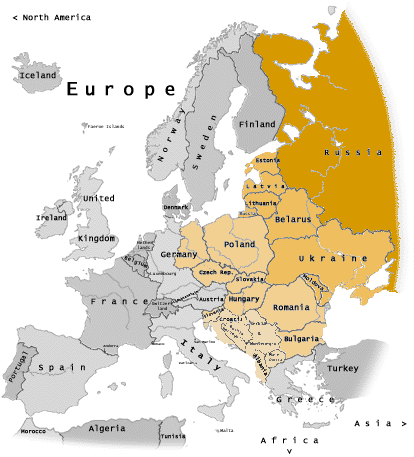
Pre-1989 division between the "West" (grey) and "Eastern Bloc" (orange) superimposed on current borders: Russia (the former RSFSR) Other countries formerly part of the USSR Members of the Warsaw Pact Other former Communist states not aligned with Moscow

The political borders of Eastern Europe were largely defined by the Cold War from the end of World War II to 1989. The Iron Curtain separated the members of the Warsaw Pact (in red) from the European members of NATO (in blue).
Russia ended its participation in the First World War in March 1918 and lost territory, as the Baltic countries and Poland became independent. The region was the main battlefield in the Second World War (1939–45), with German and Soviet armies sweeping back and forth, with millions of Jews killed by the Nazis, and millions of others killed by disease, starvation, and military action, or executed after being deemed as politically dangerous.[41] During the final stages of World War II the future of Eastern Europe was decided by the overwhelming power of the Soviet Red Army, as it swept the Germans aside. It did not reach Yugoslavia and Albania however. Finland was free but forced to be neutral in the upcoming Cold War. The region fell to Soviet control and Communist governments were imposed. Yugoslavia and Albania had their own Communist regimes. The Eastern Bloc with the onset of the Cold War in 1947 was mostly behind the Western European countries in economic rebuilding and progress. Winston Churchill, in his famous "Sinews of Peace" address of March 5, 1946, at Westminster College in Fulton, Missouri, stressed the geopolitical impact of the "iron curtain":
Eastern Bloc during the Cold War to 1989
Eastern Europe after 1945 usually meant all the European countries liberated and then occupied by the Soviet army. It included the German Democratic Republic (also known as East Germany), formed by the Soviet occupation zone of Germany. All the countries in Eastern Europe adopted communist modes of control. These countries were officially independent of the Soviet Union, but the practical extent of this independence – except in Yugoslavia, Albania, and to some extent Romania – was quite limited.
The Soviet secret police, the NKVD, working in collaboration with local communists, created secret police forces using leadership trained in Moscow. As soon as the Red Army had expelled the Germans, this new secret police arrived to arrest political enemies according to prepared lists. The national Communists then took power in a normal gradualist manner, backed by the Soviets in many, but not all, cases. They took control of the Interior Ministries, which controlled the local police. They confiscated and redistributed farmland. Next, the Soviets and their agents took control of the mass media, especially radio, as well as the education system. Third, the communists seized control of or replaced the organizations of civil society, such as church groups, sports, youth groups, trade unions, farmers organizations, and civic organizations. Finally, they engaged in large scale ethnic cleansing, moving ethnic minorities far away, often with high loss of life. After a year or two, the communists took control of private businesses and monitored the media and churches. For a while, cooperative non-Communist parties were tolerated. The communists had a natural reservoir of popularity in that they had destroyed Hitler and the Nazi invaders. Their goal was to guarantee long-term working-class solidarity.[42][43]
Under pressure from Stalin, these nations rejected grants from the American Marshall plan. Instead, they participated in the Molotov Plan which later evolved into the Comecon (Council for Mutual Economic Assistance). When NATO was created in 1949, most countries of Eastern Europe became members of the opposing Warsaw Pact, forming a geopolitical concept that became known as the Eastern Bloc.
First and foremost was the Soviet Union (which included the modern-day territories of Russia, Lithuania, Latvia, Estonia, Belarus, Ukraine, and Moldova). Other countries dominated by the Soviet Union were the German Democratic Republic, People's Republic of Poland, Czechoslovak Socialist Republic, People's Republic of Hungary, People's Republic of Bulgaria, and Socialist Republic of Romania.
The Socialist Federal Republic of Yugoslavia (SFRY; formed after World War II and before its later dismemberment) was not a member of the Warsaw Pact. It was a founding member of the Non-Aligned Movement, an organization created in an attempt to avoid being assigned to either the NATO or Warsaw Pact blocs. The movement was demonstratively independent of both the Soviet Union and the Western bloc for most of the Cold War period, allowing Yugoslavia and its other members to act as a business and political mediator between the blocs.
The Socialist People's Republic of Albania broke with the Soviet Union in the early 1960s as a result of the Sino-Soviet split, aligning itself instead with China. Albania formally left the Warsaw pact in September 1968 after the suppression of the Prague spring. When China established diplomatic relations with the United States in 1978, Albania also broke away from China. Albania and especially Yugoslavia were not unanimously appended to the Eastern Bloc, as they were neutral for a large part of the Cold War period.
Since 1989

existing members new members in 2013Croatia

existing members new members in 2007BulgariaRomania

existing members new members in 2004CyprusCzech RepublicEstoniaHungaryLatviaLithuaniaMaltaPolandSlovakiaSlovenia
With the fall of the Iron Curtain in 1989, the political landscape of the Eastern Bloc, and indeed the world, changed. In the German reunification, the Federal Republic of Germany peacefully absorbed the German Democratic Republic in 1990. In 1991, COMECON, the Warsaw Pact, and the Soviet Union were dissolved. Many European nations which had been part of the Soviet Union regained their independence (Belarus, Moldova, Ukraine, as well as the Baltic States of Latvia, Lithuania, and Estonia). Czechoslovakia peacefully separated into the Czech Republic and Slovakia in 1993. Many countries of this region joined the European Union, namely Bulgaria, the Czech Republic, Croatia, Estonia, Hungary, Latvia, Lithuania, Poland, Romania, Slovakia and Slovenia. The terminology EU11 countries refer the Central, Eastern and Baltic European member states which accessed in 2004 and after: in 2004 the Czech Republic, Estonia, Latvia, Lithuania, Hungary, Poland, Slovenia, and the Slovak Republic; in 2007 Bulgaria, Romania; and in 2013 Croatia.
The economic changes were in harmony with the constitutional reforms, while provisions on public finances can be identified and in some countries, a separate chapter deals with public finances. Generally, they shortly encountered the following problems: high inflation, high unemployment, low economic growth, and high government debt. By 2000 these economies were stabilized, and sooner or later between 2004 and 2013 all of them joined the European Union. Most of the constitutions define directly or indirectly the economic system of the countries parallel to the democratic transition of the 1990s: free-market economy, which sometimes complemented with the social or socially (and ecologically) oriented attribute, economic development, or only the economic rights are included as a ground for the economy. In the case of fiscal policy, the legislative, the executive and other state organs (Budget Council, Economic and Social Council) define and manage the budgeting. The average government debt in the countries is nearly 44 %, but the deviation is great because the lowest figure is close to 10 % but the highest is 97 %. The trend shows, that the sovereign debt ratio to GDP in most countries has been rising. Only three countries are affected by high government debt: Croatia, Hungary and Slovenia (over 70% of the GDP), while Slovakia and Poland fulfill the Maastricht requirement but only with 10% below the threshold. The contribution to cover the finances for common needs is declared, the principle of just tax burden-sharing is supplemented sometimes with special aspects. Tax revenues expose typically 15 – 19 % of the GDP, and rates above 20% only rarely can be found. The state audit of the government budget and expenditures is an essential control element in public finances and an important part of the concept of checks and balances. The central banks are independent state institutions, which possess the monopoly on managing and implementing a state’s or federation’s monetary policy. Besides monetary policy, some of them even perform the supervision of the financial intermediary system. In the case of price stability function, the inflation rate, in the examined area, relatively quickly dropped to below 5 % by 2000. In monetary policy the differences based on the eurozone, Estonia, Latvia, Lithuania, Slovakia, Slovenia use the common currency The economies of this decade – similar to the previous one – show a moderate inflation As a new phenomenon, a slight negative inflation (deflation) appeared in this decade in several countries (Croatia, Estonia, Hungary, Poland, Romania, Slovakia, and Slovenia), which demonstrates sensitivity regarding international developments. The majority of the constitutions determine the national currency, legal tender or monetary unit. The local currency exchange rate to the U.S. dollar shows, that drastic interventions were not necessary. National wealth or assets are the property of the state and/or the local governments, and as an exclusive property, the management and protection of them aim at serving the public interest.[44]
See also
Community for Democracy and Rights of Nations
Eastern European Group
Eastern Partnership
Eurasian Economic Union
Euronest Parliamentary Assembly
Eurovoc
Future enlargement of the European Union
Geography of the Soviet Union
List of political parties in Eastern Europe
N-ost
Organization of the Black Sea Economic Cooperation
Post-Soviet States
East Slavs
South Slavs
Orthodox Slavs
Russian explorers
Eastern Romance people
European Union
Intermarium
- European geography
Eurovoc#Eastern Europe
Central Europe
Northern Europe
Southeast Europe
Central and Eastern Europe
East-Central Europe
European Russia
Geographical midpoint of Europe
Regions of Europe

